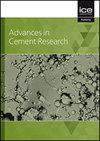Effect of nano-silica@ chitosan phosphate ester on the mechanical properties and water resistance of magnesium oxychloride cement
IF 1.4
4区 工程技术
Q3 CONSTRUCTION & BUILDING TECHNOLOGY
引用次数: 0
Abstract
Nano-silica is used in various composite materials as a kind of filler with good performance. In this study, hydrogen peroxide was used to repair and activate the hydroxyl group on the surface of nano-silica, and chitosan phosphate ester was loaded onto the surface of nano-silica through intermolecular dehydration to prepare nano-silica@ chitosan phosphate ester, and nano-silica@ chitosan phosphate ester was added to the magnesium oxychloride cement for water resistance modification. The results showed that the addition of nano-silica@ chitosan phosphate ester increased the compressive strength of magnesium oxychloride cement at different ages, and the compressive strength of the modified magnesium oxychloride cement at 7 days and 28 days were 116 MPa and 127 MPa, respectively, which increased by 11.5% and 5.8% compared with the unmodified samples. The compressive strength of the modified magnesium oxychloride cement reached 102 MPa after 28 days of water immersion, which was 8.3% higher than that of the phosphoric acid modified sample under the same water immersion duration. At the same time, it was found that nano-silica@ chitosan phosphate ester can increase the fluidity of magnesium oxychloride cement slurry, accelerate the hydration reaction rate and refine the pores.纳米二氧化硅@壳聚糖磷酸酯对氧氯化镁水泥机械性能和耐水性的影响
纳米二氧化硅作为一种性能优良的填料被广泛应用于各种复合材料中。本研究采用过氧化氢对纳米二氧化硅表面的羟基进行修复和活化,通过分子间脱水将壳聚糖磷酸酯负载到纳米二氧化硅表面,制备出纳米二氧化硅@壳聚糖磷酸酯,并将纳米二氧化硅@壳聚糖磷酸酯添加到氧氯化镁水泥中进行耐水性改性。结果表明,纳米二氧化硅@壳聚糖磷酸酯的加入提高了不同龄期氧氯化镁水泥的抗压强度,改性后的氧氯化镁水泥在7天和28天时的抗压强度分别为116兆帕和127兆帕,与未改性样品相比分别提高了11.5%和5.8%。水浸泡 28 天后,改性氧氯化镁水泥的抗压强度达到 102 兆帕,比相同水浸泡时间下的磷酸改性样品高出 8.3%。同时还发现,纳米二氧化硅@壳聚糖磷酸酯能增加氧氯化镁水泥浆体的流动性,加快水化反应速度,细化孔隙。
本文章由计算机程序翻译,如有差异,请以英文原文为准。
求助全文
约1分钟内获得全文
求助全文
来源期刊

Advances in Cement Research
工程技术-材料科学:综合
CiteScore
3.70
自引率
5.00%
发文量
56
审稿时长
3.2 months
期刊介绍:
Advances in Cement Research highlights the scientific ideas and innovations within the cutting-edge cement manufacture industry. It is a global journal with a scope encompassing cement manufacture and materials, properties and durability of cementitious materials and systems, hydration, interaction of cement with other materials, analysis and testing, special cements and applications.
 求助内容:
求助内容: 应助结果提醒方式:
应助结果提醒方式:


